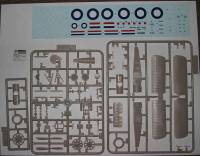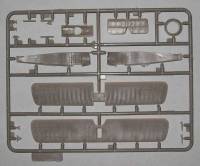Roden 1/72nd Scale Sopwith 2F1 Camel
|
 |
History
The Sopwith Camel hardly needs any introduction to aircraft fans. Probably
the most famous World War One aircraft after the Fokker Dr.I, the Camel
appeared as the British and Commonwealth's major single seat fighter aircraft
late in the war. Deliveries of 2F1's began in November 1917. These variants
of the Camel were designed to be used from ships, taking off from tiny
platforms, or sometimes using lighters towed by ships. According to Bruce,
in July 1918, a troupe of 2F1's made history by mounting the first ever
carrier-borne air strike. After the end of World War One, 2F1's appeared
in the Baltic theater and operated against the neophyte Bolshevik regime.
The Kit
 In
the box, we find two sprues of nicely detailed parts in the usual grey
medium-hard plastic used by Roden. There is a little flash but nothing
to be concerned about. Spare parts abound - a propeller, a choice of front
fuselage pieces, and a couple of engines. A comparison with the drawings
in the 2F1 Windsock Datafile shows the fuselage about right though the
wings appear a little long and the wing tips need a little sanding to
shape. However, one should be cautious about relying too much on drawings
for accuracy. There is excellent detail in the fuselage interior. A small
frame is provided upon which one mounts the seat and fuel tanks. The top
of the fuselage is separate and while this means one needs to be careful
assembling the components, this eliminates the concern of lost stringer
detail from sanding the center seam. In
the box, we find two sprues of nicely detailed parts in the usual grey
medium-hard plastic used by Roden. There is a little flash but nothing
to be concerned about. Spare parts abound - a propeller, a choice of front
fuselage pieces, and a couple of engines. A comparison with the drawings
in the 2F1 Windsock Datafile shows the fuselage about right though the
wings appear a little long and the wing tips need a little sanding to
shape. However, one should be cautious about relying too much on drawings
for accuracy. There is excellent detail in the fuselage interior. A small
frame is provided upon which one mounts the seat and fuel tanks. The top
of the fuselage is separate and while this means one needs to be careful
assembling the components, this eliminates the concern of lost stringer
detail from sanding the center seam.
 The
decals allow for four schemes all from 1918: 1) N6603, HMS Pegasus; 2)
N6602, HMS Furious (a curious latticework pattern covers the fuselage;
3) N7149, Turnhouse Naval School; 4) N7120, HMS Queen Elizabeth. The decals
look excellent and the red centers for the roundels are provided separately
to prevent any registration problems. The
decals allow for four schemes all from 1918: 1) N6603, HMS Pegasus; 2)
N6602, HMS Furious (a curious latticework pattern covers the fuselage;
3) N7149, Turnhouse Naval School; 4) N7120, HMS Queen Elizabeth. The decals
look excellent and the red centers for the roundels are provided separately
to prevent any registration problems.
Conclusion
In summary, an excellent-looking kit that should be straightforward
to build. Inexpensive and well made, I recommend this kit highly.
References
J. M. Bruce. "Sopwith 2F1 Camel." Windsock Datafile Number
6. Albatros Publications, Berkhamsted, Hertfordshire, England. Second
edition, 1996.
Acknowledgement
Thanks to Roden for the review
copy.
|
|
